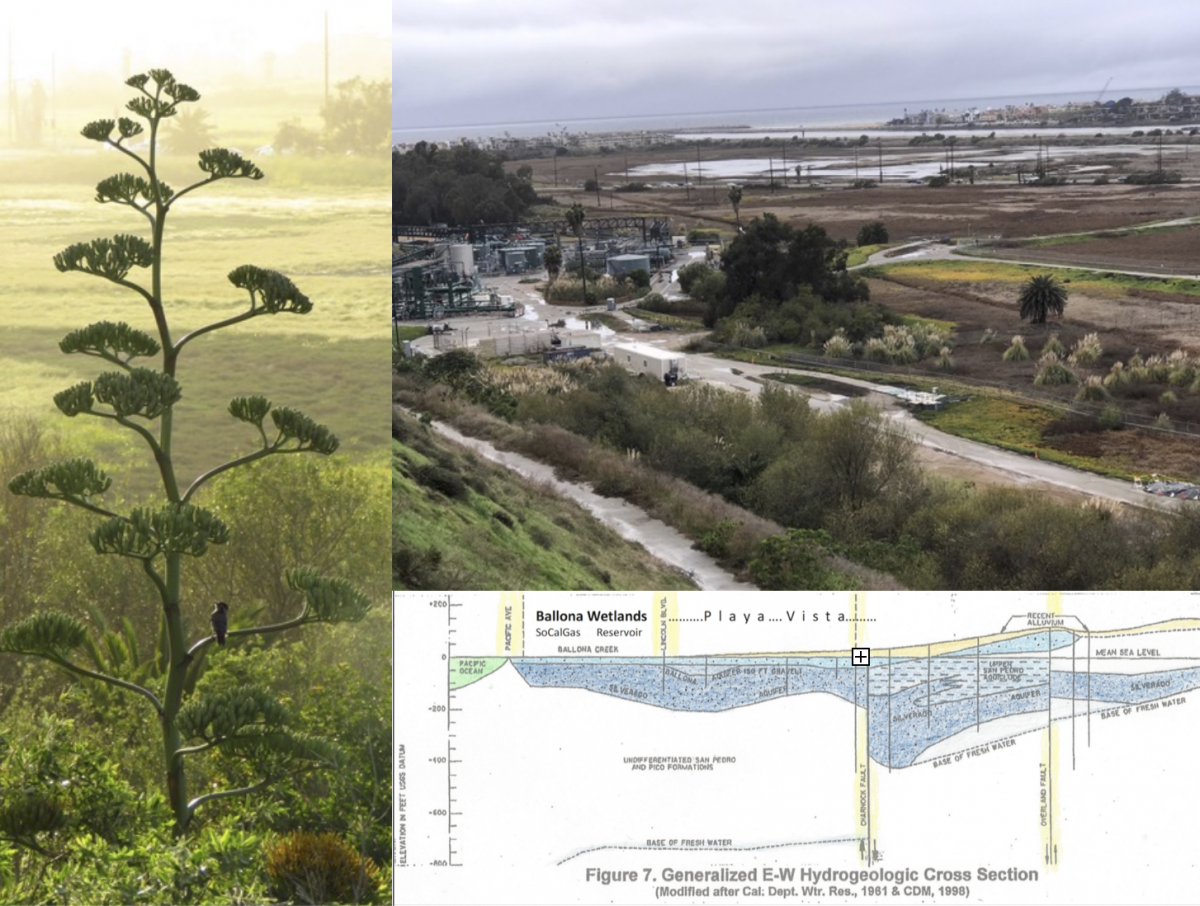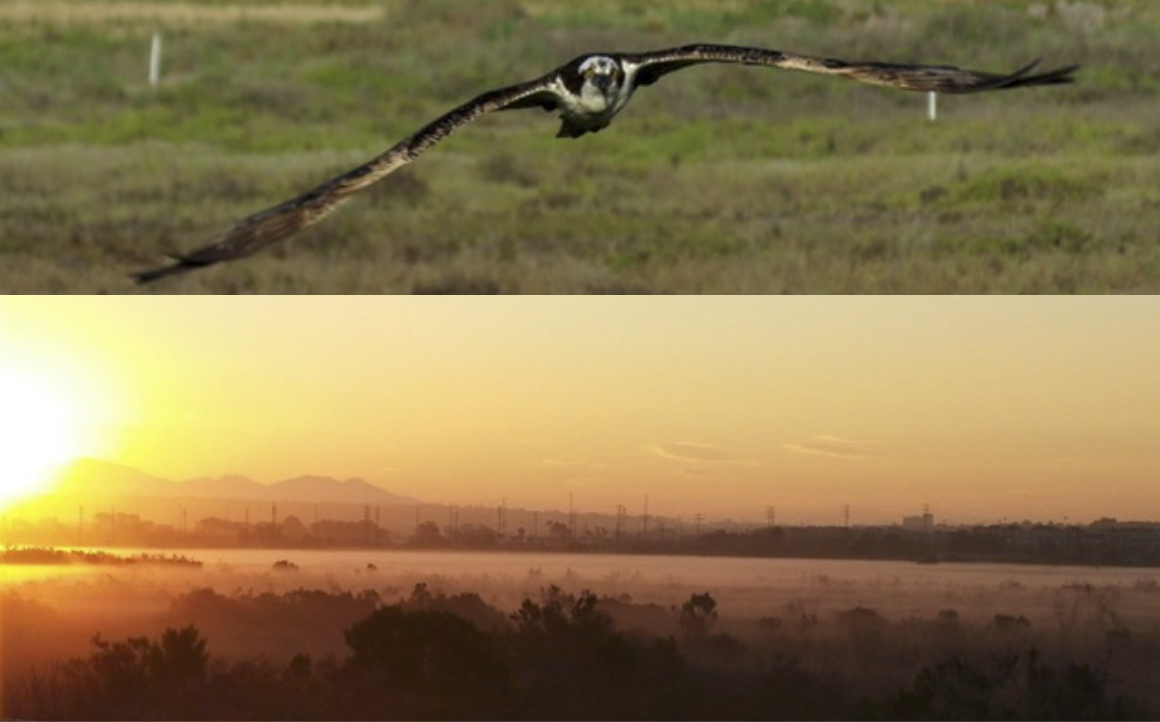July 31, 2019

Ballona Wetlands by Jonathan Coffin (left) and SOCALGAS/PDR by Jeanette Vosburg (right)
The Ballona Wetlands Ecological Reserve is rare, one of the last surviving seasonal freshwater habitats contiguous to the California Coastline. On the surface, it consists of historical ecological wetlands - dunes, grasslands, salt flats, freshwater riparian habitat, indigenous sacred sites & below the surface, groundwater that feeds the wetlands via multiple underlying freshwater aquifers which overlie the ever deeper Playa del Rey Oilfield.
Classified as an Ecological Reserve, the Ballona Wetlands has been entitled the highest level of habitat protection.
And yet…
Management by the California Department of Fish and Wildlife, with funding by the Coastal Conservancy & USEPA, has created a highly delicate & controversial task for three principal reasons:
First, due to one of the most devastating droughts in the history of California – 2011-2019, and due to systematic pumping, diversion, and draining of Ballona Wetlands groundwater by the Playa Vista Development over the past twenty years, all the while under the watchful eye of ‘management’, it has been declared degraded & impaired. Ballona Wetlands has suffered from human manipulation, including infusion with saltwater and polluted Channel water, systematic corporate dewatering, and soil, water, and habitat contamination by escaping toxic gases.
Second, the Playa del Rey Oilfield was converted into a gas storage field in 1942. SoCalGas/ Playa del Rey underground high-pressure gas storage operations underlie the entire Ballona Wetlands Ecological Reserve, extending to high-density neighborhoods, reaching out to affect over 2,000 acres.
In a SoCalGas study done in 1953, 25% of the injected storage gas was discovered migrating into the adjoining Venice Oilfield at the reservoir level of approximately 6,000 feet. SoCalGas operational procedure is based on capturing as much of the leaking gas as possible, and returning it to the primary storage field on an ongoing basis. An expansion permit for enlarging the field beyond its original 240 acres, south of Ballona Channel does not exist. Over 200 abandoned oil wells are in the area, which used 1930’s era technology for well abandonment including telephone poles used to plug the wells.
Today, we know SoCalGas operations are responsible for migrating and escaping toxic gases via aging, corroding and leaking wells and infrastructure, contaminating the air, soil and underlying freshwater. The Department of Fish and wildlife has turned a blind eye with no meaningful evaluation of SOCALGAS issues in its Environmental Impact Report for Ballona’s restoration. USEPA likewise.
The California Council of Science and Technology, in a 2018 report commissioned by the California State Legislature, characterizes the Playa del Rey facility as one of the most dangerous underground gas storage facilities in California.
Third, after a 15-year struggle, the Sierra Club, along with other environmental organizations, fought Playa Vista land developers who wanted to bulldoze and develop the 640 acres that was to become the Ballona Wetlands Ecological Reserve. We won and Ballona was entitled with the highest level of protection extended to natural habitats by the State of California.
However...
Today, 15 years after acquisition, bulldozers are once again raising their blades and threatening to destroy Ballona. The Department of Fish and Wildlife is commissioning a $200M publicly funded “Grand Water Park” project, marketed to dig out and move 3 million plus cubic yards of earth; destroy habitat, flora and fauna, twenty to thirty feet deep down; build five miles of earthen levees twenty to thirty feet high covering over eighty acres of the wetlands; and inundate and blanket what’s left with millions of acre-feet of tidal saltwater, opening the Ballona Wetlands Ecological Reserve to the tides, storm surges, and sea level changes of the Santa Monica Bay, destroying the traditional seasonal freshwater wetland in order to replace it with a saltwater tidal bay. The consortium of private, public, and non-profit entities, including the California Department of Fish and Wildlife, Playa Capital, SOCALGA/PDR, and others, audaciously labels this market scheme as an ecological restoration.
In a recent Prop 65 lawsuit for groundwater contamination, SCG’s Settlement Agreement cites that if the current ‘drinking water’ classification is removed, then they would not have to remediate the groundwater under drinking water standards.
The Sierra Club is mounting a national campaign. We will protect the Ballona Wetlands Ecological Reserve. Stay tuned. You’ll be hearing from us.

Osprey is by Jonathan Coffin and Tule Fog by Johntommy Rosas member of the Tongva Nation - description:
1. Sunrise photo shows wetlands- still there/low level fog/alive
2. Natural back lighting from sun- beginning a new day for life and wetlands etc. Personal hope for life and preserving nature including social awareness to activism
3. Power poles in the distance - Development held back away from natural resources
4. Mountains silhouette has another display of nature’s layers/levels
5. Mountains / clouds top - uphill
6. Wetlands / fog - bottom of nature - downhill
